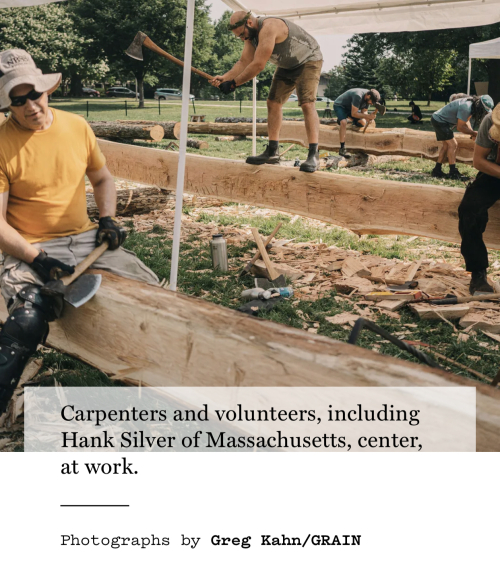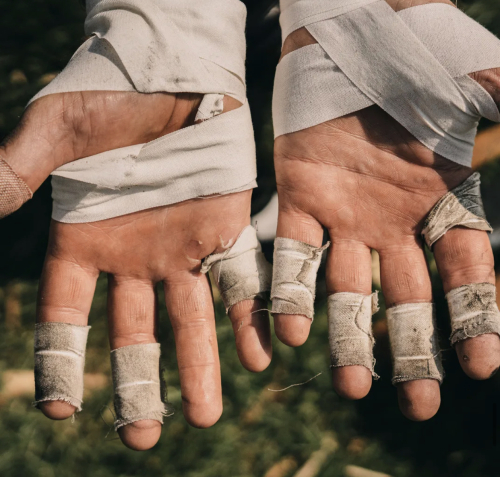My cousin Joan sent me this article. I hope you will enjoy it.
Text Shawn Mc Creesh by Photos by Greg Khan
“I started getting calls as soon as the fire was put out,” said Rick Brown, standing on the lawn at Catholic University the other day. Brown and his wife, Laura, are the co-founders of Handshouse Studio, an educational nonprofit that replicates large historical objects using the precise techniques with which they were built. In 2011, he led a trip to Poland to rebuild by hand the Gwo?dziec synagogue, raised in the 17th century and then razed by the Nazis. This time, the calls were about a much bigger house of worship: the Cathedral of Notre-Dame de Paris, nearly swallowed by an inferno in April 2019. Today, he and his tribe were here with hand axes. A few miles away, on Capitol Hill, Congress was metaphorically hammering out a way to rebuild infrastructure; here, these master builders and apprentices were literally doing the same. The giant oak logs laid out here would soon, perhaps, become hand-hewn pieces of a church.
Notre Dame
Text Shawn Mc Creesh by Photos by Greg Khan
In the final pages of The Hunchback of Notre Dame, when Quasimodo scrambles through the rafters of his lair, Victor Hugo wrote in 1831 of the “prodigious timber-work so dense it was called ‘the forest.’” La forêt was a latticework constructed from over 1,300 oak trees, mostly in the 12th century. An electrical short probably started the fire; by the time it was finally extinguished, the cathedral’s twin towers and flying buttresses held, but la forêt and the spire went up like the Hindenburg. Even before the smoke cleared, a debate burst forth about how Notre-Dame would be restored. As Hugo wrote, “Each face, each stone of the venerable monument, is a page not only of the history of the country, but of the history of science and art.” Suddenly, modernists were jockeying to impose some glass-and-steel devilry atop the old dame. One firm proposed rebuilding the roof using plastic recycled from the ocean. Another wanted to put a swimming pool up there. Just imagine how Hugo, who decried the modest cosmetic tweaks to the building done in his time — “In the name of ‘good taste,’ fashion has clapped on the wounds of Gothic architecture the wretched gewgaws of the day,” he wrote — would react to seeing the cathedral transmogrified into a branch of Soho House.
All those ideas were dismissed when, last year, French president Emmanuel Macron decreed that the cathedral be reconstructed just as it had been. Dieu merci, thought traditionalists. Brown knew immediately that he wanted to get in on the reconstruction of la forêt, and knew just whom to dial: François Calame, the head of a group called Charpentiers Sans Frontières, or Carpenters Without Borders. The group acted as a liaison between Brown and the officials at Notre-Dame. They happily sent Brown blueprints of the wooden trusses that made up the attic. He decided he and his group would focus on rebuilding truss No. 6, which stood above the choir and was one of the oldest, and send it to the French as a gesture of American goodwill. It was some 35 feet tall and 45 feet across.
“Each truss is totally unique,” explained Brown. He’s 72, and was quivering with delight in his Stetson and brown vest. “It’s like a story being told, ‘Oh, looks like here the roof was leaking and there’s some kind of failure in the corner joint,’ so they had to scab in some pieces of wood, and you see how the history is really documented. These trusses they built were very ingenious; you can see how they were learning by doing.”
Massachusetts College of Art and Design, called on the disparate peoples of the lumberverse to join him. They would assemble in Washington, D.C., where Catholic University would let them crash in dorm buildings and use the grounds in front of its basilica, the largest Roman Catholic church in North America. Members of the Timber Framers Guild; students from the oldest trade school in America, North Bennet Street School; and other characters likely to be covered in Mortise & Tenon magazine all heeded his summons.
“What you’re seeing here is very anthropological,” said Brown. “There’s nothing that’s contrivance. All these things are based on how it was done in the 12th century.” He even ordered handmade axes from a blacksmith in France. “Everyone’s been out here just hewing like a son of a gun — it’s really pretty exciting,” he exclaimed.
The sweet smell of sap and fresh wood chippings wafted across the lawn while Ethan Higgins, a lumberjack who had traveled here from Ann Arbor, Michigan, hacked away at a 40-foot white oak. He looked the part, in his suspenders and plaid. It was a sweltering, swampy summer afternoon. A bead of sweat rolled down the bridge of his nose as he announced, “This is so much fun.”
“I just love axes,” he added, proudly pointing out that he fashioned the handle of his from hop hornbeam, also known as ironwood. Hewing a nearby log was a man with the uncanny Dickensian name of Will Truax, pronounced “True-Axe.” “I’m using both felling axes and broadaxes,” said Truax, 60. “If you want to get in with any of these guys or gals, just talk tools and they will open their hearts to you,” said Alicia Spence, the project manager. Some of the looks on the lawn that day — knee-high shin guards, pleated pants that were high-waisted and flared, bloodied hands, and plenty of torn plaid — seemed more befitting of Alexander McQueen’s notorious “Highland Rape” runway show than a construction site. “This corner of timber framing lends itself to preservationists,” explained Spence, “so you get the folks who are very deep into traditional stuff, and sometimes that spills into the clothing.”
In another corner of the lawn, a group clustered around a copy of a drawing from the year 1111, animatedly debating the merits of Swedish versus Norwegian cleaving techniques. A few feet away stood Charlotte Wampold, 28, who was missing her own graduation from the North Bennet Street School to be here. She said that, once Brown invited her class to get in on the project, “There was really no question. There was just stunned silence and then cheering.”
“The original roof stood for 800 years,” Wampold pointed out. “So if we do our jobs right, that could be the same.”
There was just one little problem. When the truss is completed, no one knows for sure whether the French will actually take it.
The restoration architects, Rick Brown explained, were “so impressed that the Americans were interested in doing this, and [are] really responding favorably to the idea.” But, he added, “they said that at this stage everything is so complicated, and so political, and with so many unknowns” that there was just no telling whether they could accept an overseas shipment carrying truss No. 6. It’s one hell of an undertaking to build on spec.
A few days before construction began, the last of the white oaks for the truss were being felled 200 miles southwest of D.C., in Virginia. Smoke from the California wildfires had drifted east, crawling over the Blue Ridge Mountains and hanging in the Shenandoah Valley that day. On the grounds of Ecco Adesso Vineyards, beyond a patch of Riesling and Cabernet Franc grapes, I met Mez Welch on the edge of a sylvan thicket.
He’d spent months finding people like Michael and Cierra Weatherly, the owners of this vineyard, who would donate trees for the project. Then, said Welch, “We spent one month just walking through the woods and handpicking trees that will actually work. You might find two out of a hundred. A lot of shapes curve too much, and you can’t get the straight piece out of ’em that you need.” Diameter matters, too: If the trunk is too wide, “you’ll end up hewing three times as much wood to get to the piece, and we’re doing it in D.C. in July — it’s hellacious work. We’ve struggled so much not just with the physical aspects of this work, but the mental drain of looking at a tree for ten minutes and [thinking] it looks perfect from 14 out of 15 views, and then you notice some weird little kink and it’s terrible.”
Welch, who is 34, was with his friend Ross Beebe, 39. “Yeah, I got sucked into it,” laughed Beebe, lighting up a Winston while he leaned on his axe. “What’s two months of your life?” He eyed up an oak and muttered, more to himself than anyone, “They never look that big — ’til you start beatin’ on ’em.” In keeping with the medieval methods, many of the trees these two cut for the truss were pulled out of the forest by horses. “I called a guy in Floyd County who is like the guru of horse logging and asked him to be involved,” said Welch. His wiry gray hair was pulled back into a bun and he wore black Converse sneakers and jean shorts. Stepping up to a tree, he took his first thwack. “It’s brutal,” he remarked. “Your hands just blister up immediately.”
If all this labor seems crazy for a spec project, you don’t know tree people. I grew up the son and nephew of arborists. Think it was nuts when Michael Jackson dangled baby Blanket out of a window in Berlin? My dad used to put me 45 feet in the air in the little bucket on his DT466 Bucket Truck. I played in mulch. When I got suspended from school, I was made to sweep up behind the crew at stump-removal jobs. These people love trees the way Hitchcock loved a blonde — they love looking at them, and then they love cutting them down.
So nobody seemed the least bit bothered that their beloved truss might never see the Seine. “The dissemination of all this knowledge as a result of a catastrophic loss — that’s the silver lining here,” said Timothy Farina, 24, a D.C.-based architect who was hewing away on the lawn at the University. “We’re still making history by doing this,” said Welch. “From what we understand, even if this one doesn’t make it, we might be able to build a second one down the line that will.” The French told Brown that, when the plans for la forêt are closer to being solidified, they might call on their friends in America to build another, more exact truss, if they can’t take this one. “So far, they are still very supportive, and we haven’t gotten a thing saying it can’t happen,” said Brown. “So as long as they’re still hanging in there, we’re still hanging in there. And, doing two of these? That just means more people, more hoopla, more excitement.”
Until they knew for sure, this spec truss would come to rest at the National Building Museum for a while. First, though, it needed to be raised. It lay flat on the grass last Tuesday morning, with yellow ropes tied around the beams. His eminence Wilton Cardinal Gregory, Archbishop of Washington, blessed the wood as the basilica’s bell tolled in the background. Everyone grabbed a rope and heaved. It stood.
A lead carpenter stepped forward. “There is a tradition that with a successful raising, there is an honoring of the forest, and an honoring of the wood and of the craft, to send the youngest crew member to the highest spot of the frame to attach a piece of evergreen,” he said. “So in our case, it’s young Nevan.”
Twenty-year-old Nevan Carling pulled himself on to a crossbeam. Victor Hugo wrote that Quasimodo’s intimacy with the cathedral was such that there was “no depth which he had not penetrated, no height he had not scaled. Many a time he had clambered up its front to various elevations with no help except the rough surface of the sculpture.” Now Carling clambered up to the top of the new truss and affixed a sprig of cedar of Lebanon. “It was scary,” he said of the climb, “but I knew where everything was, ’cause we all worked on it together.”






Leave a Reply